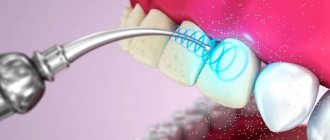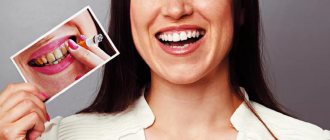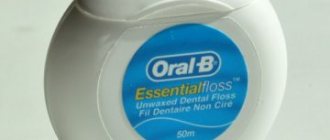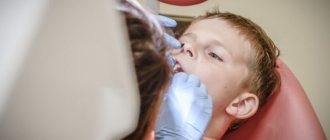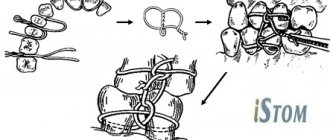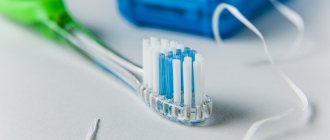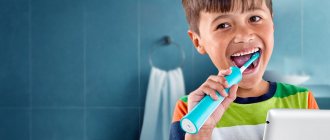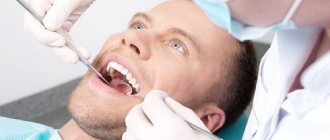In the first years of life, a child’s milk teeth erupt, he gradually begins to eat food familiar to adults, and a chewing reflex is formed. During this period, it is important to choose the right hygiene products so that the child has healthy and strong teeth in the future.
Today we will tell you how to choose your first brush and paste, prevent the development of caries in the early stages without going to the dentist, and also get through the eruption of baby teeth.
- Where do babies get caries?
- Hygiene products for the first 6 months
- What should the first brush be?
- What kind of pasta should a child under 3 years have?
- How to cure tooth decay without a dentist
- When to wean off a pacifier to avoid problems with bite
- Rules for oral care up to 3 years
- Tips from a pediatric dentist: video
Where do babies get caries?
Local immunity in the child’s oral cavity develops gradually; the first bacteria are transmitted from the mother at birth and during feeding. Initially, the oral cavity is sterile, and the microflora is formed when contacts with the outside world occur: parents lick a pacifier or bottle, try complementary feeding with a baby spoon, kiss the child.
During these contacts, bacteria are transmitted to which the immune system adapts, but it can fail due to sudden changes or illness. Transmission of harmful bacteria most often occurs at an early age through the so-called “window of infection,” but it is also possible at earlier or later periods.
The child’s microflora is not yet ready and cannot cope with many infections: thrush or stomatitis fungus, streptococci and staphylococci (provoke the development of sore throat), as well as E. coli and the herpes virus.
One of the latest studies states that the most commonly transmitted infection is Streptococcus mutans. It is this that provokes the development of caries. Moreover, it is transmitted even if the parent does not have carious teeth, since the adult’s body is more prepared to cope with viruses and infections - cariogenic bacteria do not have time to form caries in the enamel. But the baby’s body is just learning, and the baby’s risk of developing caries is higher because of this. Therefore, dentists recommend limiting contact: various licks and kisses.
The main sources of transmission of cariogenic bacteria in a child under 3 years of age: tasting food during complementary feeding, licking pacifiers, bottles and toys, kissing
Bathing
You need to bathe your baby every day before feeding (the baby should not be full or hungry), at a time convenient for you, for 5–7 minutes. At your request, the following can be added to the water: herbal infusions, special bathing products (milk, lotion, oil, foam - they all have their own indications). Our consultants will help you choose the product that best suits your child. It is recommended to bathe with soap no more than once a week. Up to 3 weeks of age (until the umbilical wound heals), it is better to bathe a baby in boiled water at a temperature of 37.5-38 oC. Lower the child into the water slowly, first the legs, then the body, so that the upper chest and head are above the water. Up to 1.5–3 months, the baby can be swaddled before bathing (and at any other time you can use free swaddling), and the procedure becomes an imitation of being in the womb. In the bath, you must pay attention to the eyes, ears, nose, genital tract and all folds. When removing the child from the bath, cover him with a pre-prepared diaper and towel. Before you start treating the skin, you can first feed the baby, while the baby is fed, he adapts to the conditions of the room, dries out a little, and only then you can apply the cream, treat the umbilical wound, dress, etc.
A newborn baby requires a lot of attention and care. And we hope that these short notes and advice from our specialists will help you properly organize hygienic care for your miracle.
Hygiene products for the first 6 months
It usually takes 6–10 months before the first teeth appear. Oral hygiene at this time is just as important as after teething, since it affects the formation of strong local immunity and the bite of teeth in the future. Note that during this period, parents should pay attention to three things in their baby’s oral care arsenal: the right pacifiers, cleaning wipes with xylitol, and a gel to facilitate teething.
Orthodontic nipples
If you use pacifiers, firstly, they must be orthodontic, and secondly, do so before 6 months, when the first teeth begin to cut. After 6 months, the pacifier may affect future bite formation.
Removal of pacifiers until 8-9 months of age forms the correct bite and helps the development of the jaw. According to studies of dental anomalies, more than half of the complaints about malocclusion are received during the period of early mixed dentition (6–9 years), but the formation of the position of the teeth begins in infancy. Parents of children participating in the study indicated that the upper incisors were tilted due to the bad habit of sucking pacifiers and fingers.
In addition, it is at this age that the sucking reflex is replaced by a chewing one, so it will be psychologically easier for the child to wean himself off the pacifier.
Philips AVENT Ultra Air pacifier 0-6 months with a pattern (2 pcs) SCF345/20
AVENT Ultra Air night pacifier 0-6 months (2 pcs) SCF376/12
Philips AVENT Ultra Air pacifier 0-6 months (2 pcs) SCF244/20
Wipes with xylitol
Until the child has his first teeth, it is recommended to use sanitary napkins with xylitol. They help maintain normal pH levels and reduce acidity levels in the mouth. Due to the increased level of acidity in the mouth, a favorable environment is created for the proliferation of many bacteria: for example, cariogenic and thrush bacteria.
To use, wrap a napkin around your finger and clean the surface of the oral cavity: gums, tongue, teeth.
Teething gels
When teething, the child may develop a fever and begin coughing from the constant flow of saliva. To avoid mistaking these symptoms for ARVI or another disease, pay attention to the following signs.
- The gums turn red and become white in places where they erupt.
- Saliva flows profusely.
- The baby puts his hands and toys into his mouth to relieve the itching.
- The baby may throw food, does not eat enough, overeats, which can cause an upset stomach.
To make teething easier, try massaging the gums with a silicone fingertip or give your child a special teether. And if local massage does not help, try special gels. They work well with teethers and finger guards and also relieve inflammation. These gels contain only harmless components of plant origin.
Jack N Jill Silicone Finger Brush (6-12 months)
Teether brush miradent INFANT-O-BRUSH yellow
Oral gel Pierre Fabre Pansoral First teeth
Teething gel BabyDerm Teething gel, 30 ml
Caring for a newborn: advice from a pediatrician
The neonatal period, as the early period of extrauterine existence, is calculated from the moment of birth to the 28th day of life. This is an important stage in the child’s adaptation to new conditions: an extrauterine type of blood circulation is established, the bronchopulmonary system and digestive tract begin to function, the blood supply to the liver changes, the functions of the skin and mucous membranes become more complicated, the immune system is activated, and independent thermoregulation is established. However, due to the functional immaturity of organs and systems characteristic of this period of development, it is at the age of the newborn that a number of borderline conditions appear that must be taken into account in organizing child care.
Due to the immaturity of most organs and systems, including the central nervous system, from birth a child exhibits only unconditioned reflexes (swallowing, sucking, proboscis, searching, grasping, etc.), and it is the presence and severity of physiological reflexes, their preservation for a certain period time and subsequent decline, along with the dynamics of body weight, are one of the main criteria for the normal development of an infant and his physical health [1].
The proportions of a newborn's body have their own characteristics. The head is large, the limbs are relatively short. The midpoint along the length of the body is located in the navel, while at an older age it shifts to the level of the pubic joint. By the time of birth, the skin is completely histologically structured, all appendages are developed (hair, nails, sebaceous and sweat glands), but there is a relative failure of a number of important functions, primarily barrier and thermoregulatory. There are intertriginous areas - axillary, cervical, popliteal and inguinal folds, which are the main areas of natural occlusion, and the area under the diaper is an area where artificial occlusion can occur. The dermis layer of a newborn child is structurally underdeveloped and is thinner compared to the dermis of an adult. More pronounced dry skin is noted; the sweat glands in full-term newborns are formed at the time of birth, but only after a few weeks of life they are fully involved in the process of sweating. In breastfed children, the sebaceous glands are more actively exposed to androgen stimulation, which often leads to the development of neonatal acne. Full-term newborns have a neutral or slightly alkaline skin surface reaction (pH > 6.0), which during the first day of life can decrease to 5.0, while in premature infants the skin pH is > 6.0 and only approaches the end of the first month of life to 5.0. It is in optimal conditions of an acidic environment that non-pathogenic saprophytes on the surface of the skin control the growth of opportunistic and pathogenic microorganisms. A prolonged alkaline reaction can cause the growth of foreign bacteria and fungi with the development of an inflammatory process [2].
There are characteristic features of the anatomical structure and functional activity of the digestive organs. The mucous membrane of the oral cavity and gastrointestinal tract is thin, dry and easily wounded. The secretory function of the digestive glands is reduced, which is manifested by a small amount of digestive juices and low enzyme activity. This greatly complicates the movement and digestion of food if the latter is not appropriate for the child’s age. The stomach of a newborn is located horizontally, the esophagus is relatively short, and the Gubarev valve (a fold of the mucous membrane that prevents the reverse reflux of food from the stomach) is almost not pronounced. There is a physiological weakness of the cardiac sphincter, while the muscular layer of the pylorus is well developed, which predisposes to regurgitation and vomiting. In addition, this may cause regurgitation of gastric contents, aspiration and the development of aspiration pneumonia.
Intestinal motility in newborns is more active, which contributes to frequent bowel movements. In the first three days, meconium (original feces) is passed - a thick, viscous mass of olive or dark green color. The next 2–4 days, the stool is characterized as transitional: it is more frequent, unevenly colored (dark green, yellow-brown), inhomogeneous with inclusions in the form of lumps and mucus. Subsequently, the stool becomes homogeneous, mushy, and yellow in color. The frequency of bowel movements depends on the nature of feeding and, as a rule, corresponds to the frequency of feedings. It is important to remember that high motor activity of the intestine in combination with insufficient fixation of its loops, morphofunctional immaturity of peripheral innervation and central regulation, low enzymatic activity promoting increased gas formation, the period of formation of microbiocenosis determines the tendency to frequent manifestations of functional disorders (infantile colic, dyschezia), and also a high risk of intussusception.
During the newborn period, a number of characteristics of the child are observed, due to mechanisms of adaptation to new conditions of existence, which are borderline (transient). These include physiological jaundice, melena, sexual crisis, physiological loss of body weight, uric acid infarction, physiological erythrocytosis, transient deficiency of vitamin K and K-dependent blood coagulation factors, etc. However, it is necessary to evaluate the severity and duration of manifestation of these conditions, as this may be an important criterion for the presence and progression of various abnormalities in the child’s health. The issue of carrying out appropriate treatment and preventive measures needs to be decided only individually.
Adequate and regular care for a newborn, taking into account the anatomical and physiological characteristics of the child’s body in this period of the postnatal period, is an important condition for maintaining the healthy state of the child and preventing various diseases; it is an element of hardening and hygienic education, as well as the formation of adequate psycho-emotional contact in the family. The main components of daily care include bathing, daily washing of the face, toileting of the eyes, nose, ears, care of the perineum and perianal area. Important components of the normal development of a baby are walks in the fresh air, compliance with temperature conditions, indoor humidity, control of feedings and bowel movements.
The optimal temperature in the room is 22 °C with a humidity of 50–70%; it is necessary to regularly ventilate the room, since the need for oxygen at this age is 2.5 times higher than in adults. It is advisable to remove carpets and bedspreads, sofa cushions, soft toys and other objects on which dust can accumulate from the child’s room. Children under 6 months should be bathed daily; after six months, you can bathe every other day. The water temperature should be 37–37.5 °C, the duration of the procedure is 5–7 minutes.
When organizing care for a newborn, a number of rules must be followed:
- The child should not be dressed in tight-fitting clothes that have a large number of frills, fasteners, folds, etc.; do not wrap up - a newborn is very sensitive to overheating, clothes and diapers should consist of natural cotton or blended fabrics, soft, with good breathability;
- use diapers with high absorbent properties, which helps maintain the required skin pH and prevents microbial colonization, reduce the time of skin contact with a wet diaper, change them in a timely manner (on average every 2-3 hours during the day and 1-2 times during night sleep ), immediate diaper change is necessary after defecation;
- It is better to dry the skin by blotting movements using paper towels or soft cotton diapers, avoid the use of alcohol-containing products: disposable baby wipes containing alcohol, fragrances or preservatives can cause skin irritation and increase the risk of allergic contact dermatitis.
The morning toilet of a newborn consists of wiping the face and washing the eyes with a cotton swab moistened with boiled water. Each eye is washed with a separate swab in the direction from the outer corner to the bridge of the nose. The baby's nasal passages have to be cleaned quite often. To do this, cotton swabs made from sterile cotton wool can be used, which are lubricated with sterile petroleum jelly or vegetable oil and carefully moved with rotational movements 1.0–1.5 cm deep into the nasal passages. Each nasal passage is cleaned by separate flagella. Toilet of the external auditory canals is carried out similarly as needed. The oral cavity is treated only in case of thrush. It is strictly forbidden to use dense objects (cotton swabs, matches with twisted cotton wool, etc.).
Creams, ointments, lotions and sprays are used as external products for baby skin care, but when using them, a number of important features must be taken into account: safety and effectiveness; no side effects; possibility of application to large surfaces of affected skin without systemic exposure; ease of use; possibility of long-term use; affordable price. It is important to follow a number of rules: do not change the dosage form of the official drug, as this will change its physicochemical and pharmacodynamic properties; do not mix ointments and creams of different compositions; remember that the effect of using external agents appears after some time and is consolidated with regular use [3, 4].
Quite often one has to deal with such a manifestation of motor dysfunction of the digestive tract as hiccups, which is characterized by convulsive contractions of the diaphragm and is most often caused by an overfilling of the stomach with gases. If hiccups occur immediately after eating, it is necessary to place the baby in an upright position for more convenient passage of gases. If it appears between feedings, you should carefully turn the baby either to the left or to the right side. In a number of infants, air leaves the stomach well when lying on their stomach.
Often, in order to remove gases from the child’s intestines, parents resort to gas tubes or enemas, which can be unsafe, especially in newborn children with easily wounded mucous membranes. At the same time, some babies get rid of gas quite easily on their own, while in others, excessive gas formation contributes to the development of colic.
Currently, to ensure the healthy growth and development of a child, parents have in their arsenal modern baby hygiene items, electronic scales, children's ear thermometers, smart toys, children's toothbrushes with a limiter, bottles with a heating indicator, pacifiers with an anti-vacuum effect, nasal aspirators, baby scissors with a rounded end, diapers, diaper panties, baby monitors, etc. Modern baby care products include Windi® disposable gas tubes (rectal catheters) and the NoseFrida® nasal aspirator.
The Windi® gas outlet tube is intended for one-time use to relieve babies of excess gases. This rectal catheter has no loose parts or components. The specially calculated length of the catheter allows it to be inserted to the desired depth to the sphincter, the spasm of which prevents the spontaneous removal of gases from the intestines, and its special configuration with a limiter helps to avoid too deep insertion. The Windi® catheter is quite soft and flexible, has a smooth rounded end, which ensures maximum safety and eliminates trauma to the rectal mucosa.
Before using the Windi® Gas Tube, massage your baby's tummy by gently moving your hand from the right side to the center of the tummy and then downwards to direct the gases towards the anus. Then do a similar massage on the left side. It is recommended to repeat the massage 3 times on each side. It is necessary to lubricate the catheter with baby cream, oil or petroleum jelly before insertion. You should lift the legs of the child lying on his back and carefully insert the catheter into the anus, similar to a thermometer. The release of gases is accompanied by a characteristic sound. A small amount of feces may be passed along with gas. Sometimes it is necessary to repeat the procedure several times to achieve the desired result. During one procedure, it is possible to use the same catheter several times, but after its successful completion, the catheter should not be stored and reused: its reuse after some time may be unsafe. It is recommended to use the catheter no more than three times a day, which does not affect the development of addiction and does not reduce the baby’s natural reflexes.
Quite often, to ensure adequate breathing and hygiene of the nasal cavity of a newborn child, especially during respiratory infections, the use of a nasal aspirator is recommended. Due to the fact that the openings of the nostrils and nasal passages at this age are relatively narrow, and the mucous membrane is abundantly supplied with blood capillaries, when there is a runny nose, pronounced swelling occurs and mucus secretion increases, which contributes to difficulty in nasal breathing. In addition, the Eustachian tubes connecting the nasal and ear cavities are relatively short, wide and horizontal, which often leads to translocation of infection with the development of otitis media.
There are a large number of aspirators: mechanical, electric, bulb aspirator, etc., however, mechanical aspirators have an undeniable advantage, as they are effective, simple and easy to use and, unlike electric ones, do not create unnecessary noise that can frighten a child.
The NoseFrida® nasal aspirator has a long suction catheter. The tube into which the mucus will flow is quite voluminous, this allows the child to treat two nasal passages in succession. The tip of the aspirator has a special narrowed atraumatic shape. It fits tightly to the nostril, which prevents trauma and irritation of the sensitive mucous membrane. The hygiene of the procedure is ensured by the presence of a replaceable filter in the NoseFrida® aspirator, which completely prevents the possibility of aspirate getting into the oral cavity of the person performing the procedure.
Literature
- Preventive Pediatrics / Ed. A. A. Baranova. M: Union of Pediatricians of Russia, 2012. 692 p.
- Gregory K. Microbiome aspects of perinatal and neonatal health // J Perinat Neonatal Nurs. 2011, 25: 158–162.
- Blume-Peytavi U., Lavender T., Jenerowicz D., Ryumina I., Stalder JF, Torrelo A., Cork MJ Recommendations from a European Roundtable Meeting on Best Practice Healthy Infant Skin Care // Pediatric Dermatology. 2016, 33(3): 311–321.
- Skin care for a newborn baby. Scientifically based methodological recommendations. 2016. Available https://www.pediatr-russia.ru/sites/default/files/file/uhod_za_kojey.pdf.
T. A. Bokova, Doctor of Medical Sciences, Professor
GBUZ MO MONIKI named after. M. F. Vladimirsky, Moscow
Contact Information
Caring for a newborn: advice from pediatrician T. A. Bokova For citation: Attending physician No. 6/2018; Page numbers in the issue: 40-43 Tags: children, babies, hygiene, removal of gases
What should the first brush be?
Dentists recommend switching to brushing with a toothbrush when baby teeth are at least halfway through. Your first toothbrush should have a compact head and synthetic bristles. In addition to the usual toothbrush, you can use a silicone finger brush: it massages the gums and relieves itching.
4 principles for choosing your first toothbrush:
- The head of the brush should be small and cover two teeth, no more. It will be very difficult to thoroughly remove plaque with a brush with a large head due to its clumsiness.
- The brush head should have silicone pads to make cleaning safe. For babies under one year old, a protective silicone ring (limiter) will not be superfluous.
- The bristles should be soft, thick and short.
- The handle of the brush should be comfortable for both the child and the parents.
From the age of 1 year, it is important to motivate children and fuel their interest in the cleaning process. Research has shown that using electric toothbrushes can be a way to build motivation. In addition, switching to an electric device improves oral hygiene compared to a manual brush: the amount of cariogenic microflora in saliva is reduced, and the risk of developing caries is reduced.
An electric toothbrush at an early age will allow the child to get used to the vibrations in the mouth, and it will be more convenient for parents to reach the distant teeth.
3 principles for choosing your first electric toothbrush:
- For children under 5 years old, it is recommended to choose models with extra soft or soft bristles.
- If the first electric brush has a bright design depicting fairy tale or cartoon characters, the child will form a pleasant association with brushing his teeth.
- The size of the brush head should not exceed 2 cm, and the handle should be rubberized. This way, the child will gradually begin to pick up the brush on his own, and the small head will allow him to brush his teeth more thoroughly.
CURAPROX Curakid Baby (0 to 4 years)
CS Medica CS-561 Kids (from 1 to 5 years) Yellow
Mega Ten Kids Sonic Kitten
Hapica Baby DBB-1Y (from 1 to 6 years)
What kind of pasta should a child under 3 years old have?
If we look at clinical studies that were conducted on the principles of evidence-based medicine, the main component in children's toothpastes is fluoride. Only they confirm their effectiveness in preventing caries.
However, it is widely believed that children under 3 years old should not brush their teeth with fluoride toothpaste. This position is due to the risk of developing fluorosis due to an excess of fluoride in the body - destruction and darkening of the enamel. But an excess of this substance is possible only in areas with a high fluoride content in water, and is also due to genetics.
The fluorine content in water can be checked on the Russian water map. And the genetic predisposition can be determined by the attending physician after passing tests. If the quality of drinking water is normal and tests are normal, dentists usually recommend using a toothpaste with a low concentration of fluoride (up to 500 ppm) at an early age.
In addition to fluorides, it is recommended to look at the abrasiveness of the paste (up to 50 RDA), as well as the presence of therapeutic and preventive additives in the composition: enzymes, xylitol, herbal extracts.
What to look for in the composition when choosing a paste:
- Abrasives - An alternative, non-traumatic but effective abrasive is silica. It is worth giving preference to toothpastes containing this substance.
- Fluorides - Organic fluorine contains compounds such as amino fluoride (olaflur).
- Dairy enzymes - lactoferrin, glucose oxide, lysozyme, lactoperoxidase. All of them stimulate the development of beneficial microflora, strengthen local immunity and restore the acid-base balance of the oral cavity.
- Xylitol is a natural sugar substitute with properties beneficial for teeth and gums. It prevents the growth of bacteria and reduces the risk of caries.
Biorepair Kids toothpaste with strawberry flavor (from 0 to 6 years)
Apadent Kids toothpaste with strawberry and grape flavor (from 0 years old)
Toothpaste Brush-Baby Apple-mint (from 0 to 3 years)
Toothpaste Mamiae Strawberry up to 6 years
How to cure tooth decay without a dentist
It is believed that it is impossible to cure a tooth affected by caries without visiting a dentist. But only if it is not caries at the chalk spot stage - this is the initial stage of caries, when calcium is washed out of the tooth enamel. At this moment, the tooth is most susceptible to attack by cariogenic bacteria. But the damage can still be stopped without visiting the dentist.
For example, using remineralizing gels. They contain all the necessary minerals that fill the washed areas: for example, in Tooth Mousse, casein performs this function. This way the tooth regains its original appearance and receives additional protection from carious formations.
Even if a child, at first glance, does not have caries, the gel can be used for prevention.
Gel for strengthening teeth ROCS (ROCS) Medical Minerals with tuber flavor…
Gel for strengthening teeth ROCS (ROCS) Medical Minerals with fruit flavor…
Tooth gel GC Tooth Mousse Strawberry
Tooth gel GC Tooth Mousse Multifruit
When to wean off a pacifier to avoid problems with bite
The habit of putting everything in the mouth can lead to poor articulation of the tongue, lips and jaw when swallowing, as well as an open bite. Studies have shown that a child can be weaned off the habit of sucking a pacifier up to three or four years of age. But since such a habit has biomechanical reasons, it can be difficult to wean a child - in this case, the help of a psychotherapist is necessary.
To avoid problems with bite, it is important to give up the pacifier in time. By 8–9 months, if complementary foods are introduced in a timely manner, the sucking reflex is gradually replaced by a chewing reflex. It is from this age that it is recommended to start giving the baby a pacifier less - it will be psychologically and physiologically easier for him to wean himself off the habit.
At what age can you start using a children's irrigator?
You can get used to using an irrigator from the age of three. It is important to start using it carefully, gradually accustoming the child. In this case, it is important to use gentle modes, avoiding strong pressure of the liquid on the gums and teeth.
To accustom your baby to the waterpik, start using it through an entertaining game. In this case, cleaning will turn into fun, will bring joy to the child, and through this the habit of using the irrigator will be formed in the future. And this is a sure guarantee of beautiful teeth and healthy gums.
Author of the article
Rules for oral care up to 3 years
Only good hygiene can help avoid caries. To ensure effective brushing, follow these rules.
- You need to brush your teeth twice a day, in the morning after breakfast and in the evening before bed.
- The correct brush movements are sweeping, from the gums to the tip of the tooth.
- Don't forget about the inner surface of your teeth.
- Show your child that you enjoy brushing your teeth. Set an example for him.
Your child’s first impressions of going to the dentist depend on oral hygiene. When the rules are followed and caries does not occur, communication with the doctor is reduced to medical examinations and does not leave terrible memories for life.
In the future, the child will trust the dentist and will tolerate possible procedures more easily. This means that caries will be treated on time and will not lead to complications.
All the most necessary hygiene products for children from 0 to 3 years old are collected in our children's set No. 1. It includes:
- Splat Baby toothpaste with apple and banana or vanilla flavors with a fingertip included;
- Curaprox Curakid toothbrush;
- Gel Pansoral “First teeth”;
- Brush Baby wipes with xylitol;
- Toothbrush holder Miradent Funny Animals.
These are basic products that will help your child maintain healthy oral microflora and fight tooth decay.
Newborn walk
Fresh air helps increase appetite, improve metabolic processes in the body, respiratory function, and blood circulation. Children are taken out for their first walk for 10–15 minutes, then for 30–60 minutes, 2 times a day. There is still debate about the age of a child for the first walks; most doctors advise starting walks at 7–10 days. However, it turns out that excess oxygen is unusual for a newborn at this age and has a depressing effect on the brain, which is why the baby is covered with corners and taken out in doses. It is worth keeping in mind that the baby always sleeps deeply on the street, and you still have a night's sleep, and so that the child does not confuse day with night, do not let the baby sleep on the street for more than 2 hours.
